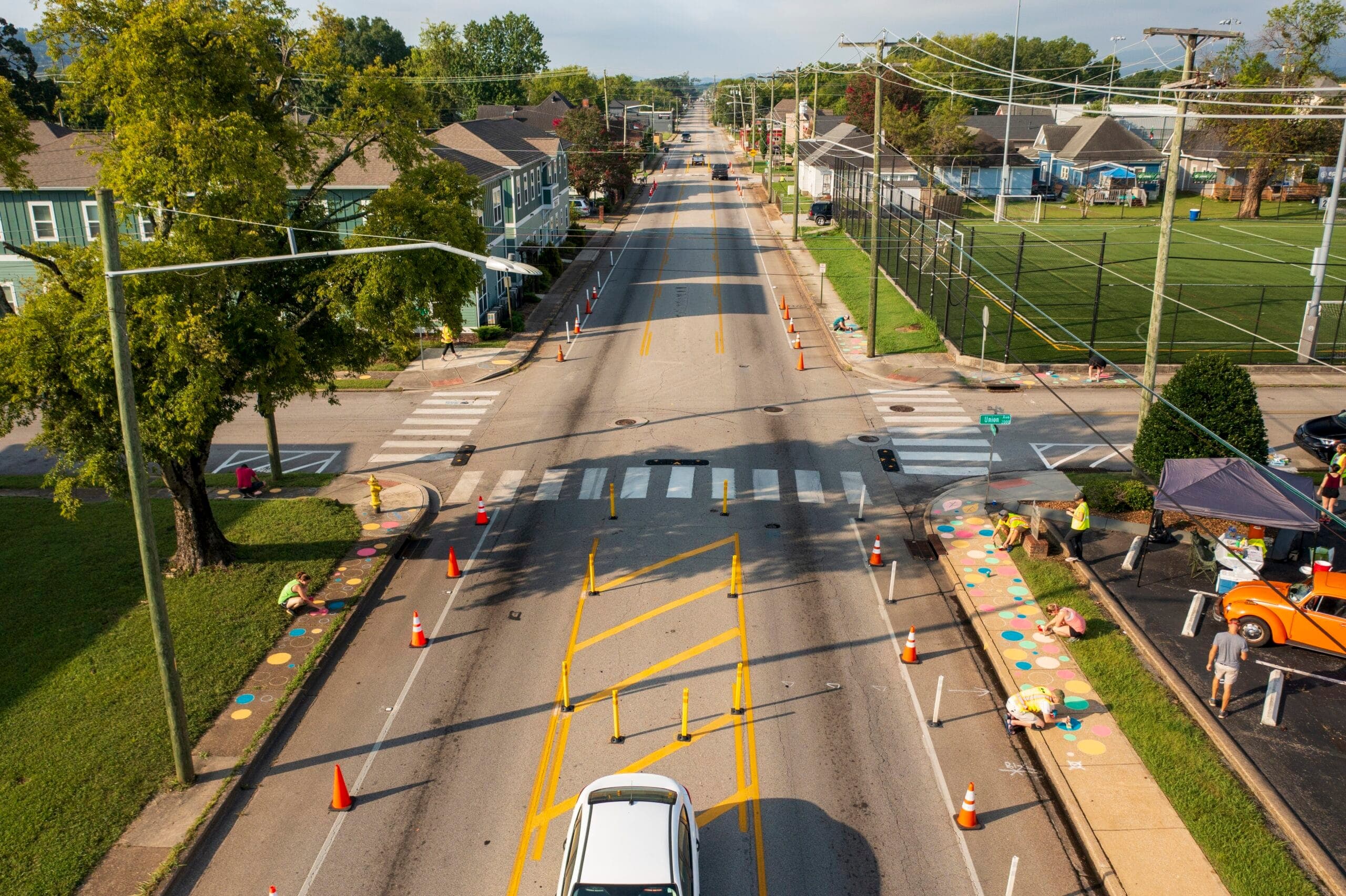
News
By Eric Cova, March 20, 2024
The City of Chattanooga has taken steps in recent years to address the safety of all road users, but it sought to find a more nimble approach to addressing dangerous street design. Their participation in the Complete Streets Leadership Academy allowed them to deliver a quick-build demonstration project on a Tennessee Department of Transportation (TDOT) state route. Read the full case study in the Complete Streets Leadership Academies Report and explore the other case studies here.
Project Snapshot
After analyzing state routes across the city, the City of Chattanooga selected South Willow Street—a state-owned road—for a quick-build demonstration that would improve the pedestrian experience and safety. Although multiple state routes have high crash rates, two intersections were selected on South Willow Street to demonstrate that safety improvements could be made at a relatively low cost and to ease coordination with TDOT.
The project installed two striped crosswalks with rubber removable medians to slow drivers and reduce the number of conflict points at the intersections where the pedestrian refuges were installed. To further reduce speeding, the project also included two removable speed bumps so that cars would have to slow before turning onto cross streets. The City of Chattanooga used flex posts and traffic paint along South Willow Street to reclaim public space for people walking and cycling. Later, they further increased visibility by using geometric shapes along the walkway, painted in colors not typically seen on roadways. Designed and installed with direct input from neighbors on both sides of South Willow Street, this sidewalk art created a sense of place by pulling inspiration from the Highland Park and Ridgedale neighborhoods.
Outcomes
The impact of the project was measured through observations, data collection, and engagement. Highlights include:
- Increased interest and positive reactions from the community. By building part of their quick build before the modular medians arrived, city personnel were able to start collecting community feedback early, improving community engagement overall and expediting the installation.
- Measurement of pedestrian activity in the area to see if the addition of safe infrastructure was impacting the way people traveled. The City of Chattanooga found that when they installed safe crosswalks, people were eager to use them.
- Thanks to this quick-build project, the City of Chattanooga will create a quick-build program with several more demonstration projects planned in the coming years.
Key Takeaways
Infrastructure improvements can reduce speeds. Slowing vehicle speed is a key tactic to improve safety for people walking and cycling because the risk of injury and death increases as driver speed increases. However, though this project was meant to improve pedestrian safety by addressing street design, it wasn’t explicitly a traffic-calming project. Even so, the mere introduction of crosswalks and flex posts naturally slowed vehicles as drivers became more aware of other road users.
One small step towards reconnecting communities. Without proper infrastructure for people to cross, South Willow Street divided two neighborhoods. However, the simple introduction of crosswalks and pedestrian refuges helped address this divide—a small step, but an initial and inexpensive one that allowed the city to help knit these neighborhoods back together.
Improvements can be cost-effective. The improvements on South Willow Street cost less than $15,000, demonstrating that a relatively small investment can quickly improve the street for all users, especially the most vulnerable users. Similar quick-build projects are efficient, low-cost tools that the City of Chattanooga can use to improve streets citywide.
Collaboration supports innovation. Buy-in from TDOT helped ensure that communication was quick and efficient. The city conferred with the state on the types of materials to use, compliance for curb ramps, and other interventions they could try on the state-owned road. Only four weeks passed between Chattanooga’s design adjustments and TDOT’s final review, which took place over email without a need for other permits.
 In 2022, Smart Growth America launched the Complete Streets Leadership Academies in Alaska, California, Connecticut, and Tennessee to equip and train local agencies and state departments of transportation to collaborate, innovate, and commit to making changes together to address safety on these dangerous state-owned roads. Cohorts were selected to plan and implement "quick-build" demonstration projects, a way to pilot and test new ideas and street designs to activate streets and better support walking, biking, and rolling.
In 2022, Smart Growth America launched the Complete Streets Leadership Academies in Alaska, California, Connecticut, and Tennessee to equip and train local agencies and state departments of transportation to collaborate, innovate, and commit to making changes together to address safety on these dangerous state-owned roads. Cohorts were selected to plan and implement "quick-build" demonstration projects, a way to pilot and test new ideas and street designs to activate streets and better support walking, biking, and rolling.This program and report was developed with funding from the Centers for Disease Control and Prevention’s (CDC) Division of Nutrition, Physical Activity, and Obesity (Cooperative Agreement CDC-RFA-OT18-1802). The views presented in this product do not necessarily reflect the views and/or positions of CDC.
Related News

© 2025 Smart Growth America. All rights reserved
Site By3Lane Marketing


















